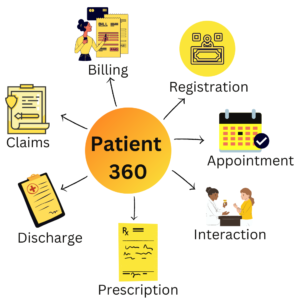Healthcare is very much important for maintaining and promoting health and managing diseases. Salesforce launches a new driver for Health Innovations, a new division inside its healthcare segment to connect healthcare providers and patients. Salesforce Patient 360 was designed to deliver patient success on a single platform. This solution enables healthcare and life sciences enterprises to deliver comprehensive patient success and equitable care more effectively by offering cost-saving automation, tailored intelligence, and real-time data.

A single view of the Patient
Healthcare professionals sometimes struggle to provide accurate, summarized services since a patient’s medical information is dispersed across numerous separate systems. In order to avoid this providers must migrate their patient databases to the cloud to build a 360-degree view of each patient.
- Consolidating patient data from across sources like EMRs, and wearable devices onto a cloud-based platform.
- Equipping patients, providers, caregivers, and partners with access to critical information whenever needed.
- Enabling healthcare teams to collaborate seamlessly from a single point of engagement that offers access to all the patients’ data.
Transform Healthcare System
Each patient has various needs. Having access to patient’s complete medical histories on a single platform enables healthcare practitioners to provide personalized medical treatments at scale. To
segment patient profiles based on factors like age, illnesses, potential dangers to their health, etc., predictive intelligence can be integrated with patient data.
Simplify healthcare solutions by assigning healthcare professionals to the proper tasks automatically, Provide the required tools and technologies to patients, partners, and the care team. Assess the availability of employees and resources to improve operational effectiveness. Improve communication between healthcare providers, labs for diagnostics, nurses, supply chain managers, and insurance firms. Providers can leverage technology to empower patients and increase happiness by using chatbots, self-service portals, and video assistance systems to provide quick direction and support.
Features:
- Provide service representatives with knowledge resources and suggestions for the best next steps so they can offer proactive support.
- Allowing patients to take control of their journey to better health through the provision of self-service platforms and online communities.
- Real-time patient health status can be provided via automated data entry from wearables and medical devices into the patient management system (PMS).
- Exchanging notifications on upcoming appointments, test results, medical advancements, etc.
Smart patient management systems have made it possible for healthcare practitioners to provide seamless and highly personalized patient experiences. Patients have total access to healthcare services via their preferred channels, such as websites, phone conversations, WhatsApp, mobile applications, and more.
A healthcare ecosystem that unifies data on a single platform offers a single source of patient truth that enables patients to use a single app or portal to schedule appointments, order medications, order tests, reserve hospital rooms, request ambulances, access their most recent medical history, submit insurance claims, and pay for any medical services. Independent of the hospital or healthcare provider a patient chooses, the user interface and navigation of health apps or portals can be standardized. In other words, patients will enjoy connected interactions and seamless changes in care providers and communication channels.



